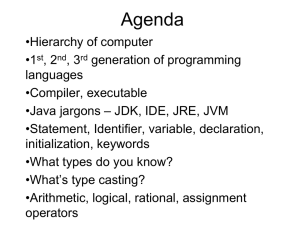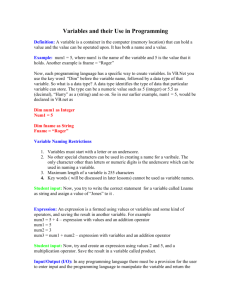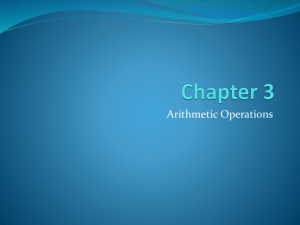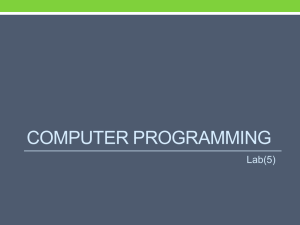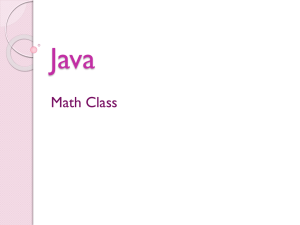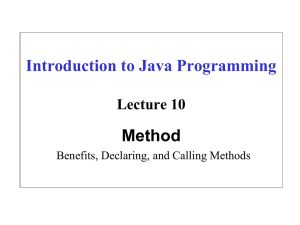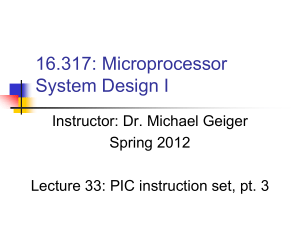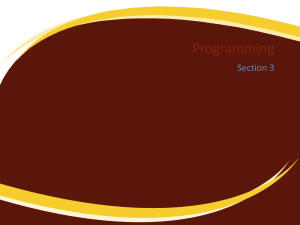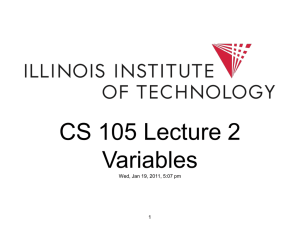Expressions and Assignment Statements
advertisement
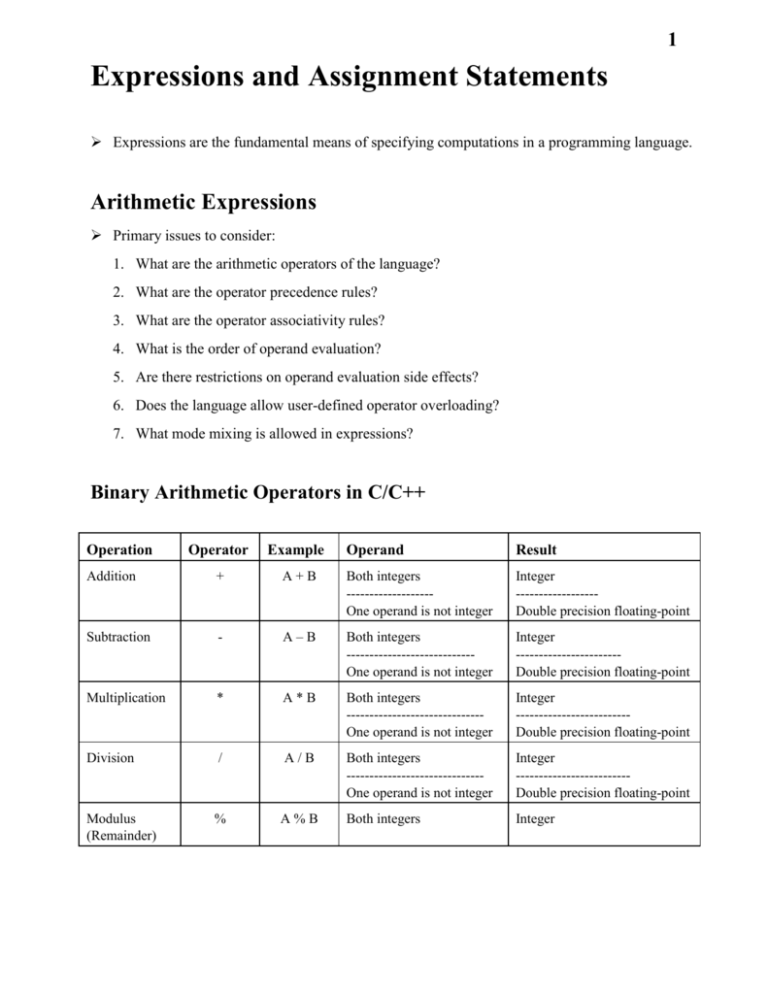
1
Expressions and Assignment Statements
Expressions are the fundamental means of specifying computations in a programming language.
Arithmetic Expressions
Primary issues to consider:
1. What are the arithmetic operators of the language?
2. What are the operator precedence rules?
3. What are the operator associativity rules?
4. What is the order of operand evaluation?
5. Are there restrictions on operand evaluation side effects?
6. Does the language allow user-defined operator overloading?
7. What mode mixing is allowed in expressions?
Binary Arithmetic Operators in C/C++
Operation
Operator
Example
Operand
Result
Addition
+
A+B
Both integers
------------------One operand is not integer
Integer
-----------------Double precision floating-point
Subtraction
-
A–B
Both integers
---------------------------One operand is not integer
Integer
----------------------Double precision floating-point
Multiplication
*
A*B
Both integers
-----------------------------One operand is not integer
Integer
------------------------Double precision floating-point
Division
/
A/B
Both integers
-----------------------------One operand is not integer
Integer
------------------------Double precision floating-point
Modulus
(Remainder)
%
A%B
Both integers
Integer
2
Evaluating Simple Arithmetic Expressions
Arithmetic expression
Result
12 + 9
21
18 - 13
5
14.78 + 3.51
18.29
12.50 * 4
50.00
15 / 2
7
15 % 2
1
15. / 2
7.50
8 / 3.0
2.666....
Unary Arithmetic Operators in C/C++ and Java
Unary Plus ( +A ):
Examples: +num, +num / 5, num1 * +num2
It has no effect on its operand in C/C++.
In Java, it causes an implicit conversion of a char, short, or byte operand to int type; otherwise, it
has no effect on its operand.
Unary Minus ( - A ):
Examples:
The pre-increment Operator:
-num, -num / 5, num1 * -num2
is specified as follows:
++<variable-name>
It says to add 1 to the current value of the variable and then to use the new value (if necessary).
The post-increment Operator:
is specified as follows:
<variable-name>++
It says to use the current value of the variable (if necessary) and then add 1 to it.
The pre-decrement Operator:
is specified as follows:
- - <variable-name>
It says to subtract 1 from the current value of the variable and then to use the new value (if
necessary).
The post-decrement Operator:
is specified as follows:
<variable-name> - -
It says to use the current value of the variable (if necessary) and then subtract 1 from it.
3
Examples
a) int num = 5;
num++ ;
// the value of variable num is not used
// num = 6
b) int num = 5;
++num;
// the value of variable num is not used
// num =
6
c) int num1 = 5, num2 = 5, result1, result2;
reult1 = ++num1 - 3; // add 1 to the value of num1, then use it
// num1 = 6 and result1 = 3
result2 = num2++ - 3; // use the value of num2, then add 1 to it
// num2 = 6 and result2 = 2
d) int num = 5;
num - - ;
// the value of variable num is not used
// num = 4
e) int num = 5;
- - num;
// the value of variable num is not used
// num = 4
f) int num1 = 5, num2 = 5, result1, result2;
reult1 = - - num1 + 3; //subtract 1 from the value of num1, then use it
result2 = num2 - - + 3; // use the value of num2, then subtract 1 from it
//num1 = 4 result1 = 7
//num2 = 4 result2 = 8
Operator Evaluation Order
Precedence:
Highest
in C++ and Java
++, - - (postfix and prefix)
Unary +, *, / , %
Lowest
Binary + , -
Associativity: in C++ and Java
Left-to right: * , / , % , binary +, binary –
Right-to left: ++ , - - , unary - , unary +
Examples
num1 + num2 – num3 + num4
----> ( ( ( num1 + num2 ) – num3 ) + num4 )
- num1++ * num2 + - - num3
----> ( ( ( - (num1++) ) * num2 ) + ( - - num3 ) )
- num1 % num2 * num3 - num4 / 6
----> ( ( ( ( - num1) % num2 ) * num3 ) – (num4 /6 ) )
4
Parentheses
The precedence and the associativity rules can be altered by placing parentheses in expressions.
A parenthesized part of an expression has precedence over its adjacent un-parenthesized parts.
User-Defined Operator Overloading
User-defined operator overloading is allowed in C++, but not in Java.
Operand Evaluation Order
Operand evaluation order refers to the order in which the values of the operands of an expression are
fetched from the memory.
For example, in the expression
A+B
Is the value variable A obtained before that of variable B or that of variable B is obtained before?
This order is important if one of the operands of an expression has side effects.
A functional side effect occurs when in a function call, the values of one or more arguments or
global variables are changed.
The order of operand evaluation is left-to-right in Java; it is not specified in C++.
Avoid expressions with side effects in any language.
Examples
int global = 5;
int funct1 ( )
{
global ++;
return 3;
}
int funct2 ( int & para)
{
Para ++;
return 3;
}
5
int main ( )
{
int num1 = 5, result1, result2;
result1 = global + funct1( );
result2 = num1 + funct2 ( num1 );
cout << “result1=\t” << result1 << “\t result2=\t” << result2;
return 0;
}
If the operands are evaluated left-to right, the output will be:
If they are evaluated right-to-left, the output will be:
result1= 8 result2= 8
result1= 9 result2= 9
Type Conversions
A mixed-mode expression is an expression in which one or more operators have operands with
different data types.
Example
int num = 3;
double result, dnum = 12.5;
result = dnum / num;
A language that allows mixed-mode expressions must provide a rule for implicit operand type
conversions (or coercion) because computers do not have binary operations that take operands with
different data types.
A narrowing conversion converts a value to a type that cannot store even approximations of all of
the values of the original type. For example, a double to int in C++.
A widening conversion converts a value to a type that can include at least approximations of all the
values of the original type. For example, an int to float in C++ and Java.
An assignment conversion is an implicit conversion that occurs when the l-value (variable) and the
value of the expression (r-value) in the assignment statement do not have the same data type.
Examples
char var;
int num1, num2;
double dnum1, dnum2;
cin >> num1 >> dnum1;
var = num1 /2;
dnum2 = dnum1 / num1;
// the integer result is converted to a character value
// the integer value in the variable num1 is converted to
// a double precision floating-point value
6
Explicit type conversions
language.
are specified by programmers by using operations provided by the
In C-based languages, these operations are called casts:
Examples:
var = (char) (num1 /2);
dnum2 = dnum1 / (double) num1;
// the integer result is converted to a character value
// the integer value in the variable num1 is converted to
// a double precision floating-point value
Logical Expressions
A logical expression (or condition) is an expression that evaluates to either true or false.
There are two types of conditions: simple conditions and Compound conditions.
A simple condition has the following syntax:
<arithmetic expression> <relational operator> <arithmetic expression>
Relational Operators
C/C++ Symbol
Meaning
<
is less than
>
is greater than
==
is equal to
<=
is less than or equal to
>=
is greater than or equal to
!=
is not equal to
A compound condition is built from simple conditions and logical operators.
Logical Operators
C++ Symbol
Meaning
Evaluation
AND
<condition1> && <condition2> is true if and only if
both conditions are true
||
OR
<condition1> || <condition2> is true if and only if at
least one of the two conditions is true
!
NOT
&&
!<condition> is true if and only if <condition> is false
7
Evaluations of compound conditions
Assuming that the variables are defined and initialized as follows:
int num1 = 5, num2 = 7, num3 = 2;
float fnum = 11.75;
char ch = ‘K’;
Compute the true value of each of the following compound conditions:
a) num1 >= 5 || num2 + 3 == num3
d) num2 + 3 == num3 * 4 || ch >= ‘Z’
b) ‘A’ <= ch && fnum + 7.2 != 2.5
e) num1 < 3 && num2 > num3
c) !(3 * num1 + 4 < num3 * 2)
f) num1 + 4 > num3 || fnum > num1 + 20 && num3 < 5
Solutions
d) num2 + 3 == num3 * 4 || ch >= ‘Z’
a) num1 >= 5 || num2 + 3 == num3
5
>= 5 ||
||
‘K’ >= ‘Z’
10 == 8
||
False
False
||
False
7 + 3 == 2 * 4
True
True
False
b) ‘A’ <= ch && fnum + 7.2 != 2.5
e) num1 < 3 && num2 > num3
‘A’ <= ‘K’ && 11.75 + 7.2 != 2.5
True
&&
18.95
True
&&
True
5 < 3 &&
!= 2.5
False
False
True
c) !(3 * num1 + 4 < num3 * 2)
!( 3 * 5 + 4
f) num1 > num3 || fnum > num1 + 20 && num3 < 5
11.75 > 5 + 20
&&
!( 19 < 4)
11.75 > 25
&&
! False
false
True
< 2 * 2)
5 >2
True
||
false
|| false
True
There is a short-circuit evaluation of a compound condition when its true value is determined without
evaluating all its individual conditions as in a), e), and f) above. Also notice in f) than the && operator has
higher precedence than the || operator.
In C++, 0 is false and anything else is true. But this is not the case in Java. So, the C++ conditions !num
(which is equivalent to num = = 0) is not valid in Java.
8
Precedence of C/C++ Operators
Operator Order of Evaluation Precedence
!
Unary –
right to left
7
left to right
6
left to right
5
left to right
4
==
!=
left to right
3
&&
left to right
2
||
left to right
1
*
/
%
+
<
<=
>
<=
Accuracy of Floating-Point Values
The fact that floating-point values are approximated inside a computer makes it difficult to test
for the equality of floating-point values.
For example, if the variable fnum is defined as follows:
Then, the condition:
fnum / 2 == 3.55
float
fnum = 7.1;
may not be true.
The problem may be solved by assuming that two floating-point values are equal if their
difference is relatively very small.
This is done by testing if the absolute value of their difference is less than a certain value chosen
by the programmer (for example 0.000001).
Using the library function fabs() that takes as argument a floating-point value and returns its
absolute value, the condition:
value1 == value2
9
is replaced with the condition:
fabs(value1 - value2) < 0.000001
which tests whether the difference between the two values is small enough so that we can make
them equal.
Conditional Expressions
in C/C++ and Java
A conditional expression has the following syntax:
<Condition > ? <expression-True> : <expression-false>
With the meaning: if <Condition> is true, the value of the expression is the value of <expressiontrue> otherwise, it is the value of <expression-false>.
Example:
average = (count = = 0) ? 0 : sum / count;
A conditional expression can be used in a program where any other expression can be used.
Example:
cin >> num1 >> num2;
cout << 2 + (num1 > num2 ? num1/ num2 : num2 / num1);
Note that if the inputs are 15 and 3, the output will be 7 and if they are 2 and 7 the output will be 5.
Assignment Statements
An assignment statement is used to store a value into a memory location.
Simple Assignments
Examples in C/C++
int num1, num2 = 15, *pt;
num2 = num2 * 7;
pt = &num1;
*pt = num2 / 4;
Assignment as an Operator in C/C++ and Java
In C-based languages (C/C++ and Java), the assignment is an operator that produces a result which
is the same as the value assigned.
It has the right-to-left associativity.
10
Examples in C/C++
int num1, num2, num3, ch;
char * pt, buffer [81] = {‘\0’};
num1 = num2 = num3 = 5;
//assign 5 to the variables num1, num2, and num3
// read values into the buffer until the end-of-file (EOF) character is encountered.
pt = buffer;
while ( (ch = cin.get( ) ) != EOF)
*pt ++ = ch;
Compound Assignment Operators in C/C++ and Java
They are specified as follows:
<variable-name>
<operator>= <expression>;
Which is equivalent to the regular assignment:
<variable-name> = <variable-name> <operator> <expression>;
Examples
Compound Assignments
Equivalent Simple Assignments
counter += 5;
counter = counter + 5;
power *= value;
power = power * value;
average /= count;
average = average / count;
total -= value;
total = total - value;
remain %= 8;
remain = remain % 8;
result /= num - 25
result = result / (num - 25);
number *= -1;
number = -number;
Conditional Targets in Perl
Examples:
flag = = 1 ? count1 : count2 = 0;
Which means:
if (flag = = 1)
count1 = 0;
else
count2 = 0;
11
Multiple Assignments in Perl, Ruby, and Lua
These languages provide multiple-target, multiple-source assignment statements.
Example
The Perl statement:
Is executed as follows:
($first, $second, $third) = (10, 20, 30);
$first = 10;
$second = 20;
$third = 30;
The statement to interchange the values of two variables can then be written as follows:
($first, $second) = ($second, $first);
Mixed-Mode Assignments
A mixed-mode assignment is an assignment in which the l-value (variable) and the value of the
expression (r-value) do not have the same data type.
Example
int sum1, num = 5;
double sum2, dnum = 12.5;
sum1 = dnum + 3,75;
sum2 = num + 10;
// narrowing conversion
// widening conversion
Mixed-mode assignments are allowed in Fortran, C, C++, and Perl and its coercion rules are similar
to those used for mixed-mode expressions: many of the possible types mixes are legal, with
coercions freely applied.
Ada does not allow mixed-mode assignments, and Java and C# allow it only if the required coercion
is widening conversion.
12
Exercises:
9 page 343 & 344; 13 page 344 and 20 page 345.
Extra credits: 2, 3, 4, 5, 6 page 343.
Assuming that the variables are defined and initialized as follows:
int num1 = 9 , num2 = 5 , num3 = 10;
float fnum = 12.50;
char ch = ‘P’;
A. Evaluate the following conditions (using short circuit evaluation whenever possible):
a) 2 * num1 - 5 >= 9 || fnum / 2 + 10 <= 6.5
b) num1 + 5 = = 24 || num1 – 1 > num2 - 5
c) num1 + num2 == num3 + 5 && 2 * num3 <= 4 * num2
d) 2 * num1 - 5 >= 9 && fnum / 2 + 10 <= 6.5
e) num1 - num2 <= num1 / 3 || num1 * num2 > 100
f) ! (num1 + 5 <= 13)
g) num1 - 5 >= num3 || num2 < 15 && num1 >= 9
B. Which of the following C++ conditions are equivalent (that means have the same true value)?
a) num1 != 0
d) !num1
b) num1 == 0
e) !(num1 == 0)
c) num1
13
Major types of Statements in an Imperative Language
1. Input statement:
to input data into the computer (program)
2. Output statement:
to output information from the computer (program)
3. Assignment statement:
to store information/data into a memory location.
4. One way-selection structure:
to execute one or more statements when a condition is true
5. two-way-selection structure:
condition.
to make a choice of action based on the true value of a
6. multiple-way selection structure:
or more conditions.
to make a choice of action based on the true values of two
7. A counter-controlled iteration: to repeat the execution of one or more statements a fixed
number of times.
8. A logically-controlled iteration: to repeat the execution of one or more statements as long as a
condition is true.
Exercises Chapter 8
1c, 2, 3c, 4, 5, 6, 8, 9 pages 383-385.
